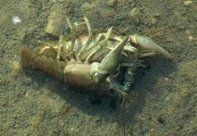My image - not nearly so amazing, is, nevertheless, amazing to me. A rotifer has cilia (hair-like fibers) that wave to bring food into its mouth. When these wave it often looks like wheels turning, thus giving them the old name "wheel animalcules". Inside the rotifer's body are trophi, or jaws which, when looking at them under a microscope, can often be seen chomping away on whatever miniscule flotsam they are devouring.
Rotifers have one or more "toes" at the bottom that emits a type of glue that enables them to adhere to the substrate then they have the ability to dissolve the glue so they can swim on to a better spot. Some rotifers are able to form a type of protective spore which enables them to live dried out for a very long time - perhaps years.
Below is a picture taken by Damián H. Zanette and obtained from wikimedia Commons.
To my knowledge and based on my research, all known rotifers are free-living: that is they are not parasites or carriers of disease. I really love these little critters.



No comments:
Post a Comment